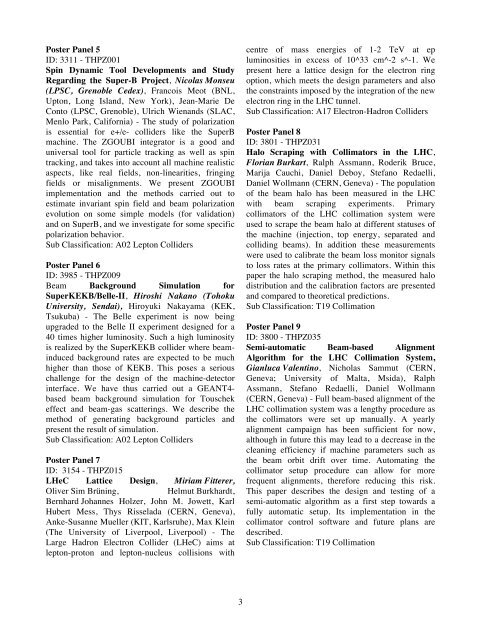Abstracts Brochure - 2nd International Particle Accelerator Conference
Abstracts Brochure - 2nd International Particle Accelerator Conference
Abstracts Brochure - 2nd International Particle Accelerator Conference
You also want an ePaper? Increase the reach of your titles
YUMPU automatically turns print PDFs into web optimized ePapers that Google loves.
Poster Panel 5<br />
ID: 3311 - THPZ001<br />
Spin Dynamic Tool Developments and Study<br />
Regarding the Super-B Project, Nicolas Monseu<br />
(LPSC, Grenoble Cedex), Francois Meot (BNL,<br />
Upton, Long Island, New York), Jean-Marie De<br />
Conto (LPSC, Grenoble), Ulrich Wienands (SLAC,<br />
Menlo Park, California) - The study of polarization<br />
is essential for e+/e- colliders like the SuperB<br />
machine. The ZGOUBI integrator is a good and<br />
universal tool for particle tracking as well as spin<br />
tracking, and takes into account all machine realistic<br />
aspects, like real fields, non-linearities, fringing<br />
fields or misalignments. We present ZGOUBI<br />
implementation and the methods carried out to<br />
estimate invariant spin field and beam polarization<br />
evolution on some simple models (for validation)<br />
and on SuperB, and we investigate for some specific<br />
polarization behavior.<br />
Sub Classification: A02 Lepton Colliders<br />
Poster Panel 6<br />
ID: 3985 - THPZ009<br />
Beam Background Simulation for<br />
SuperKEKB/Belle-II, Hiroshi Nakano (Tohoku<br />
University, Sendai), Hiroyuki Nakayama (KEK,<br />
Tsukuba) - The Belle experiment is now being<br />
upgraded to the Belle II experiment designed for a<br />
40 times higher luminosity. Such a high luminosity<br />
is realized by the SuperKEKB collider where beaminduced<br />
background rates are expected to be much<br />
higher than those of KEKB. This poses a serious<br />
challenge for the design of the machine-detector<br />
interface. We have thus carried out a GEANT4based<br />
beam background simulation for Touschek<br />
effect and beam-gas scatterings. We describe the<br />
method of generating background particles and<br />
present the result of simulation.<br />
Sub Classification: A02 Lepton Colliders<br />
Poster Panel 7<br />
ID: 3154 - THPZ015<br />
LHeC Lattice Design, Miriam Fitterer,<br />
Oliver Sim Brüning, Helmut Burkhardt,<br />
Bernhard Johannes Holzer, John M. Jowett, Karl<br />
Hubert Mess, Thys Risselada (CERN, Geneva),<br />
Anke-Susanne Mueller (KIT, Karlsruhe), Max Klein<br />
(The University of Liverpool, Liverpool) - The<br />
Large Hadron Electron Collider (LHeC) aims at<br />
lepton-proton and lepton-nucleus collisions with<br />
�<br />
3<br />
centre of mass energies of 1-2 TeV at ep<br />
luminosities in excess of 10^33 cm^-2 s^-1. We<br />
present here a lattice design for the electron ring<br />
option, which meets the design parameters and also<br />
the constraints imposed by the integration of the new<br />
electron ring in the LHC tunnel.<br />
Sub Classification: A17 Electron-Hadron Colliders<br />
Poster Panel 8<br />
ID: 3801 - THPZ031<br />
Halo Scraping with Collimators in the LHC,<br />
Florian Burkart, Ralph Assmann, Roderik Bruce,<br />
Marija Cauchi, Daniel Deboy, Stefano Redaelli,<br />
Daniel Wollmann (CERN, Geneva) - The population<br />
of the beam halo has been measured in the LHC<br />
with beam scraping experiments. Primary<br />
collimators of the LHC collimation system were<br />
used to scrape the beam halo at different statuses of<br />
the machine (injection, top energy, separated and<br />
colliding beams). In addition these measurements<br />
were used to calibrate the beam loss monitor signals<br />
to loss rates at the primary collimators. Within this<br />
paper the halo scraping method, the measured halo<br />
distribution and the calibration factors are presented<br />
and compared to theoretical predictions.<br />
Sub Classification: T19 Collimation<br />
Poster Panel 9<br />
ID: 3800 - THPZ035<br />
Semi-automatic Beam-based Alignment<br />
Algorithm for the LHC Collimation System,<br />
Gianluca Valentino, Nicholas Sammut (CERN,<br />
Geneva; University of Malta, Msida), Ralph<br />
Assmann, Stefano Redaelli, Daniel Wollmann<br />
(CERN, Geneva) - Full beam-based alignment of the<br />
LHC collimation system was a lengthy procedure as<br />
the collimators were set up manually. A yearly<br />
alignment campaign has been sufficient for now,<br />
although in future this may lead to a decrease in the<br />
cleaning efficiency if machine parameters such as<br />
the beam orbit drift over time. Automating the<br />
collimator setup procedure can allow for more<br />
frequent alignments, therefore reducing this risk.<br />
This paper describes the design and testing of a<br />
semi-automatic algorithm as a first step towards a<br />
fully automatic setup. Its implementation in the<br />
collimator control software and future plans are<br />
described.<br />
Sub Classification: T19 Collimation


